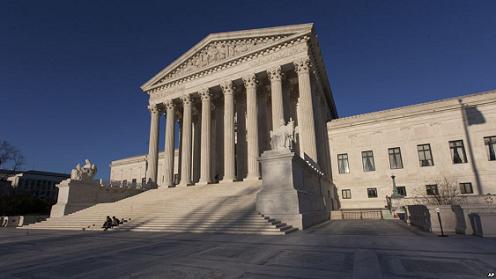by WorldTribune Staff, May 26, 2017
The Supreme Court on May 22 struck down North Carolina’s Congressional map, ruling that two districts drawn by the Republican-controlled legislature (District 1 and District 12) were unconstitutionally based on race.
The decision “illustrates the ‘heads I win, tails you lose’ nature of the liberal attack on Republican – but only Republican – gerrymandering, as the Court had previously upheld similar actions taken by North Carolina Democrats,” Dan McLaughlin noted in a National Review op-ed.

The 5-3 opinion was written by Justice Elena Kagan; Justice Clarence Thomas joined with the court’s liberals in the majority, while Justices Samuel Alito, Chief Justice John Roberts, and Justice Anthony Kennedy dissented in part. (Justice Neil Gorsuch did not participate, as the case had already been argued, and one more vote would not change the outcome).
“Naturally, the media spin on this decision is knee-jerk characterizations of Republicans as racist, but the actual issues here are about the collision between two irreconcilable visions of district-drawing: (1) the prohibition on considering race in drawing district lines, and (2) the liberal view that the Voting Rights Act requires race to be considered in order to draw ‘majority-minority’ districts,” McLaughlin wrote.
The Court’s approach “telegraphs its intention to preserve racial gerrymandering when Democrats do it, just not Republicans,” McLaughlin wrote, adding the justices have “been hearing challenges to North Carolina’s district borders every decade since the 1980s.”
In 1999, the Court first faced a challenge to District 12, which was created by the Democrat-controlled state legislature and was defended in court by Democratic Gov. Jim Hunt.
“The Democrats defended District 12 on the grounds that they had been motivated by partisanship, not race; the Court, in an opinion by Justice Thomas, concluded that the Democrats’ evidence that black North Carolinians tended to vote Democrat was enough to require a trial on the factual question of whether race was the predominant motive, rather than partisanship,” McLaughlin wrote.
Justice Thomas said that “our prior decisions have made clear that a jurisdiction may engage in constitutional political gerrymandering, even if it so happens that the most loyal Democrats happen to be black Democrats and even if the State were conscious of that fact…Evidence that blacks constitute even a supermajority in one congressional district while amounting to less than a plurality in a neighboring district will not, by itself, suffice to prove that a jurisdiction was motivated by race in drawing its district lines when the evidence also shows a high correlation between race and party preference.”
Justice Stevens, joined by Justices Breyer, Ginsburg and Souter, wrote separately but agreed at the time that “the record supports the conclusion that the most loyal Democrats living near the borders of District 12 ‘happen to be black Democrats,’…and I have no doubt that the legislature was conscious of that fact when it enacted this apportionment plan. But everyone agrees that that fact is not sufficient to invalidate the district.”
The trial court had found that District 12’s boundaries were motivated by race, noting a few additional items of evidence, the last two of which centered on the focus on race by Democrat Roy Cooper, now the governor of North Carolina: (1) that “the legislators excluded many heavily-Democratic precincts from District 12, even when those precincts immediately border the Twelfth and would have established a far more compact district … more heavily Democratic precincts … were bypassed … in favor of precincts with a higher African-American population; (2) that [a]dditionally, Plaintiffs’ expert, Dr. Weber, showed time and again how race trumped party affiliation in the construction of the 12th District and how political explanations utterly failed to explain the composition of the district; (3) that [the Democrats’ expert’s] testimony was ‘unreliable’ and not relevant; (4) that a legislative redistricting leader, Senator Roy Cooper, had alluded at the time of redistricting ‘to a need for racial and partisan balance,’ and (5) that the Senate’s redistricting coordinator, Gerry Cohen, had sent Senator Cooper an e-mail reporting that Cooper had ‘moved Greensboro Black community into the 12th, and now need[ed] to take [about] 60,000 out of the 12th.’ ”
The case came back to the Supreme Court in 2001. The Clinton administration filed a brief defending the gerrymander, “arguing that it was entirely reasonable for Democrats to gerrymander on racial lines so long as they were motivated by partisanship,” McLaughlin noted.
In a 5-4 opinion written by Justice Breyer and joined by Justices Ginsburg, Stevens, Souter and O’Connor, the Court “effectively threw out the verdict, defending to the hilt the Democrats’ right to gerrymander for partisan advantage by means of race,” McLaughlin wrote.
The Court’s May 22 decision shows that “in the context of a state where black voters are reliable Democrats and white voters lean Republican (but moreso in some parts of the state than others), this standard translates as ‘it’s OK when Democrats do it,’ ” McLaughlin wrote.
“After all, if white voters are voting with a bloc of Democrats for Democratic officeholders, Democrats can consider the race of black voters to tilt the map in the Democrats’ favor, and Republicans can’t consider the exact same factors about the exact same voters. In other words: majority-minority districts are allowed as a solution only if the problem is white voters voting Republican. Heads they win; tails you lose.”
